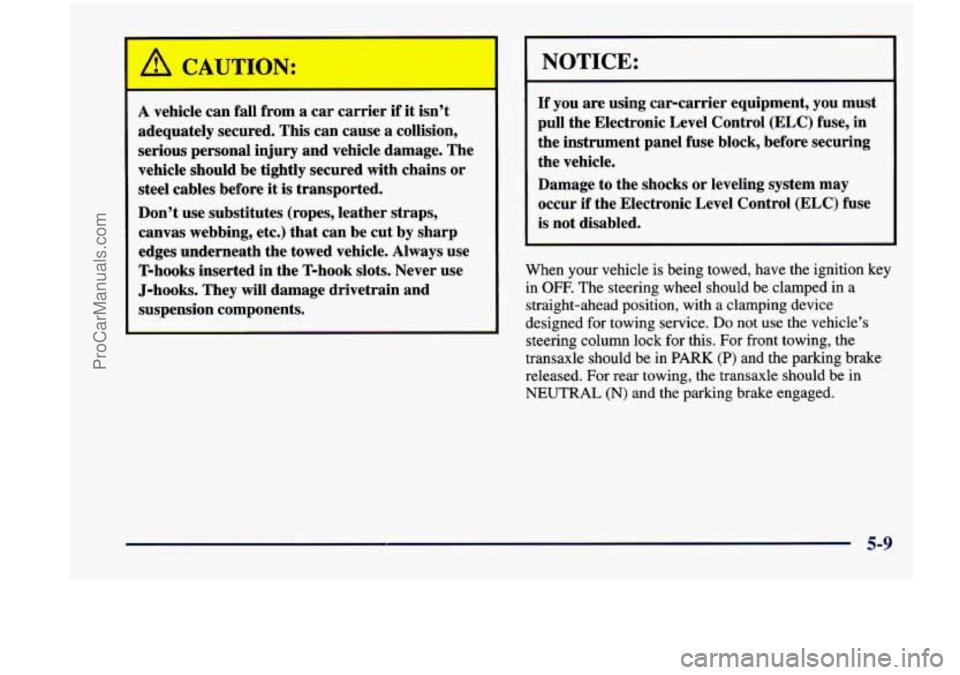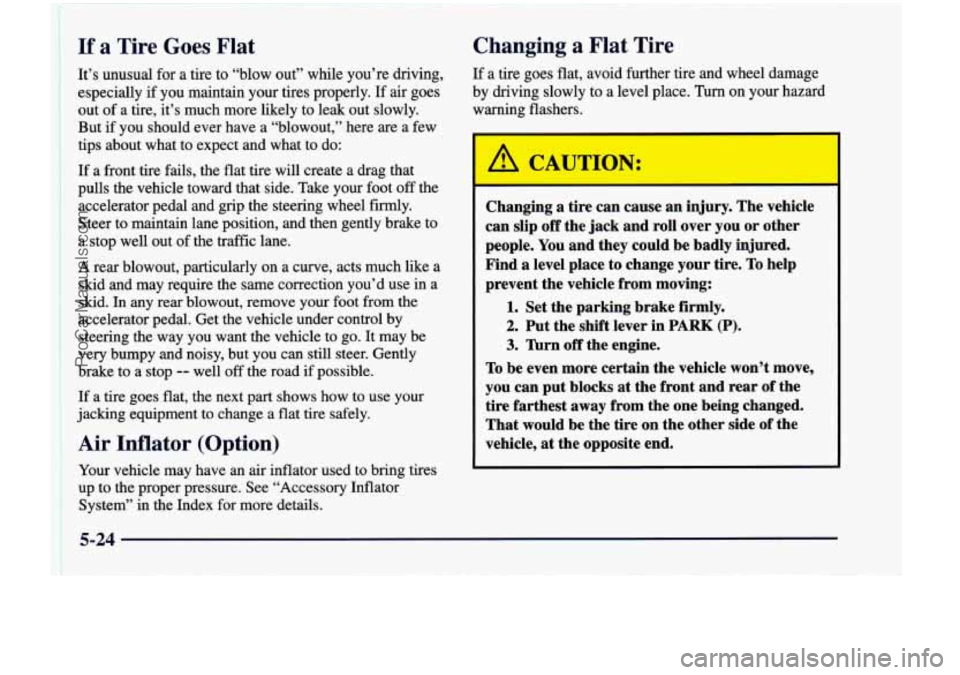Page 306 of 474

A vehicle can fall from a car carrier if it isn’t
adequately secured. This can cause a collision,
serious personal injury and vehicle damage. The
vehicle should be tightly secured with chains or
steel cables before it is transported.
Don’t use substitutes (ropes, leather straps,
canvas webbing, etc.) that can be cut
by sharp
edges underneath the towed vehicle. Always use
T-hooks inserted in the T-hook slots. Never use
J-hooks. They will damage drivetrain and
suspension components.
~~
NOTICE:
If you are using car-carrier equipment, you must
pull the Electronic Level Control (ELC) fuse, in
the instrument panel fuse block, before securing
the vehicle.
Damage to the shocks or leveling system may
occur if the Electronic Level Control (ELC) fuse
is not disabled.
When your vehicle is being towed, have the ignition key
in
OFF. The steering wheel should be clamped in a
straight-ahead position, with a clamping device
designed for towing service.
Do not use the vehicle’s
steering column lock for this. For front towing, the
transaxle should be in
PARK (P) and the parking brake
released. For rear towing, the transaxle should be in
NEUTRAL (N) and the parking brake engaged.
5-9
ProCarManuals.com
Page 307 of 474
I NOTICE:
Your vehicle has front-wheel drive; do not have it
towed with the front wheels in contact with the
ground or vehicle damage may occur.
A dolly
must be used under the front wheels when towing
from the rear or the vehicle must be transported
on a flat bed carrier.
I NOTICE:
Do not have your vehicle towed with the front
wheels in contact with the ground. This will
damage the transaxle.
If the vehicle must be towed on the front wheels,
it cannot be towed more than a total of 500 miles
(800 km) for the lifetime of the vehicle.
Front Towing
Tow Limits -- 55 mph (90 km/h), 500 miles (800 km)
Attach T-hook chains in the
front of the wheels into the
slots
of the front shipping
brackets
on the frame (both
sides). Insert the hook from
the inward side of the slot,
not the outward side.
I NOTICE:
When attaching T-hooks to the shipping slots
in the frame rail, attach them to the inside
of the frame to avoid damage to the frame or
front fascia.
5-10
ProCarManuals.com
Page 308 of 474
NOTICE:
Do not tow with sling-type equipment or the
front bumper system will be damaged. Use
wheel-lift or car-carrier equipment. Additional
ramping may be required for car-carrier
equipment. Use safety chains and wheel straps.
Towing
a vehicle over rough surfaces could
damage
a vehicle. Damage can occur from
vehicle to ground or vehicle to wheel-lift
equipment.
To help avoid damage, install a
towing dolly and raise the vehicle until adequate
clearance
is obtained between the ground and/or
wheel-lift equipment.
5-11
ProCarManuals.com
Page 309 of 474
Rear Towing
A towing dolly must be used under the front wheels
when towing
from the reay:
NOTICE:
Do not tow with sling-type equipment or the rear
bumper system will be damaged. Use wheel-lift
or car-carrier equipment. Additional ramping
may be required for car-carrier equipment. Use
safety chains and wheel straps.
Towing
a vehicle over rough surfaces could
damage a vehicle. Damage can occur from
vehicle to ground
or vehicle to wheel-lift
equipment.
To help avoid damage, install a
towing dolly and raise the vehicle until adequate
clearance is obtained between the ground and/or
wheel-lift equipment.
5-12
ProCarManuals.com
Page 321 of 474

If a Tire Goes Flat
It’s unusual for a tire to “blow out” while you’re driving,
especially if you maintain your tires properly. If
air goes
out of a tire, it’s much more likely to leak out slowly.
But
if you should ever have a “blowout,” here are a few
tips about what to expect and what to do:
If a front tire fails, the flat tire
will create a drag that
pulls the vehicle toward that side. Take your foot
off the
accelerator pedal and grip the steering wheel fiiy.
Steer to maintain lane position, and then gently brake to
a stop well out of the
traffic lane.
A rear blowout, particularly on a curve, acts much like a
skid and may require the same correction you’d use in a
skid. In any rear blowout, remove your foot from the
accelerator pedal. Get the vehicle under control by
steering the way you want the vehicle to go. It may be
very bumpy and noisy, but you can still steer. Gently
brake to a stop
-- well off the road if possible.
If a tire goes flat, the next part shows how to use your
jacking equipment to change a flat tire safely.
Air Inflator (Option)
Your vehicle may have an air inflator used to bring tires
up to the proper pressure. See “Accessory Inflator
System” in the Index for more details.
Changing a Flat Tire
If a tire goes flat, avoid further tire and wheel damage
by driving slowly to a level place. Turn on your hazard
warning flashers.
- 1
’ A CAUTION:
--
Changing a tire can cause an injury. The vehicle
can slip
off the jack and roll over you or other
people. You and they could be badly injured.
Find
a level place to change your tire. To help
prevent the vehicle from moving:
1. Set the parking brake firmly.
2. Put the shift lever in PARK (P).
3. I’urn off the engine.
To be even more certain the vehicle won’t move,
you can put blocks
at the front and rear of the
tire farthest
away from the one being changed.
That would be the tire on the other side of the
vehicle, at the opposite end.
i-24
ProCarManuals.com
Page 325 of 474
P
J
Removing the Flat Tire and Installing the
Spare Tire
If your vehicle has aluminum wheels, use
the handle of the folding
wrench to pry
the large
center cap off.
Then with the other end of the wrench, loosen the nuts.
2. If your vehicle has the plastic “bolt-on” wheel
covers,
you cannot separate the nylon wheel nut caps
from the cover. Loosen them completely using the
folding wrench, and remove the wheel cover. If the
wheel nut caps have been completely loosened, the
wheel cover will come
off easily.
5-28
ProCarManuals.com
Page 326 of 474
3. Loosen the wheel
nuts
-- but do not
remove them
-- using
the folding wrench.
(Turn the handle about
180 degrees, then flip
the handle back to the
starting position. This
avoids taking the wrench
off the lug nut for
each turn.)
(10 CM.) - 6 IN (15 CM.)
4. Near each wheel,
there
is a notch in the
vehicle’s body. Position
the jack and raise the
jack head until
it fits
firmly into the notch in
the vehicle’s frame
nearest the flat tire.
I NOTICE: I
Do not place the jack under the rear axle control
arms. Only use the areas shown for proper
jack location.
Do not raise the vehicle yet. Put the compact spare tire
near you.
ProCarManuals.com
Page 327 of 474
A CAUT'ON:
-
Getting under a veh le when it is jacked up is
dangerous.
If the vehicle slips off the jack, you
could be badly injured or killed. Never get under
a vehicle when it is supported only by a jack.
'AP UTI
Raising your vehicle with the jack improperly
positioned can damage the vehicle and even
make the vehicle fall.
To help avoid personal
injury and vehicle damage, be sure to fit the jack
lift head into the proper location before raising
the vehicle.
1 5-
Attach the folding
wrench to the jack, and
rotate the wrench
to the
right
to raise the jack
head a few inches.
6. Raise the vehicle by rotating the folding wrench to
the right in the jack. Raise the vehicle
far enough off
the ground
so there is enough room for the spare tire
to fit.
7. Remove all the wheel nuts and take off the flat tire.
5-30
ProCarManuals.com